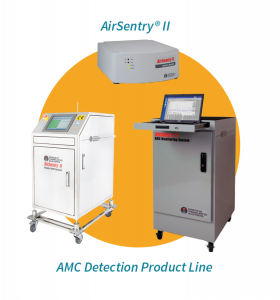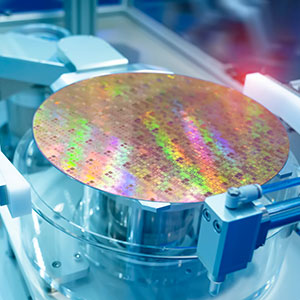The fabrication of Photolithography masks, reticles, and other precision optical components which are both defect-free and surface-contaminant-free is of critical importance within the Lithography (“Litho”) and metrology functional areas within microelectronics manufacturing. The need for real-time AMC monitoring is well established within these industries wherever optical components are manufactured and used for actinic or inspection purposes. This paper will detail the benefits and applications of Ion Mobility Spectrometry (IMS) using Particle Measuring Systems’ AirSentry® II (ASII) Real-time AMC Analyzer within the Litho, Metrology, and Photo Optical lens manufacturing areas.
The International Roadmap for Devices and Systems (IRDS 2020 Edition) places high interest on the reduction of feature defects originating from the patterned images transferred to the wafer in the Photolithography Functional Area (Litho FA) using advanced Lithography techniques. This has implications not only in the Litho FA’s developer and scanner processes, but also at the point of use wherever any high precision optical components are used, including manufacturing of 193 nm and 266 nm lasers.
Outline
- Section 1, IRDS Edition 2020 Advanced DUV and EUV Lithography Challenges,
of this paper summarizes the pertinent areas of focus per the IRDS 2020 Edition that pertain to AMC control in the Litho functional area as the semiconductor industry advances into the coming decade. - Implications extend to defect-free manufacturing of high precision optical lens surfaces used in actinic and inspection processes of the Litho Functional Area Metrology areas where high precision lenses are paramount. Section 2, AMC-Caused Haze Formation on Optical Surfaces within Lithography, Metrology, and Component (Sub-System) Manufacturing, delves into defects caused by the reaction between acidic and basic AMC resulting in optical haze formation on lenses. This is a mutually concerning challenge within the Litho Functional Area (FA) and the manufacturing processes of the Optical component itself, where pristine transmission or reflection is required within visual inspection metrology tool assembly and use. In the coming decade, Extreme Ultra Violet (EUV) Litho tools are to become more applicable in HVM environments. EUV techniques ultimately use reflective optical components (reticles/masks and mirrors) to impart patterned images into the photoresist chemistry in a vacuum environment and these components, just as in DUV (and previous generations of Litho FAs), must be protected from particle and AMC contaminants during manufacture and until final OEM tool integration.
- In a complimentary fashion, Section 3, Defects caused by AMC in the Photolithography Functional Area,
describes well-documented defects that are unique to the Photolithography FA and undesired stochastic defects associated with the overall actinic process. Focus is placed on one source of these defects involving the reaction chemistry of the Photoresist material. - Section 4, AMC Control in Precision Optical Lens Manufacturing, outlines more information about how precision optical lens manufacturing provides unique challenges. Manufacturing DUV- and EUV-compatible optics and opto-mechanical assemblies requires a level of environmental control far beyond that of traditional particulate-based cleanrooms. Depending on the wavelength and fluence (energy per area) of the UV laser, different levels of molecular contamination control are required to prevent laser damage to the optical components.
- In addition, Section 5, AirSentry II Application in Precision Optical Component and Sub-System Manufacturing, of this paper provides a real-world example of the value of AMC detection in the field of precision optical component and sub-system manufacturing. In this specific instance, a user employs the ASII Mobile Cart with ASII Total Amines and ASII Total Acids analyzers in an optics lens manufacturing process to identify, eliminate, and then control unacceptable levels of airborne ammonia AMC within the production facility.
For more information, fill out the form to download the full paper …


